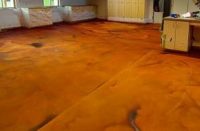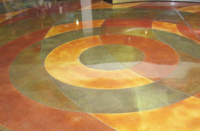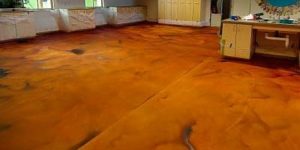When preparing a brand new concrete surface to be acid-stained, don’t take anything for granted. Every step of the new concrete pour contains elements that might affect the quality of your acid stain job.
Acid stain, as you may know, works by reacting with the composition of the concrete to create permanent and variegated color. The quality and character of the surface plays a major role in the outcome of a reactive stain project. Proper preparation of the concrete surface is a must for successful acid staining.
A specific situation that requires extra surface-preparation planning is newly poured concrete floors that you plan to acid stain. We encounter this situation more and more as the construction industry takes a turn from remodeling work to new construction. As more opportunities for working on new construction projects present themselves, we try to impress the general contractors with the importance of planning how the surface is poured, placed and finished so that we have a clean canvas to work on.
Not only have we learned how to work with contractors to make sure the concrete is poured correctly to help with our preparation, but we have also learned some new principles along the way for completing our work.
Let’s break down the pouring and finishing process into segments and take a look at how each can be better handled for successful completion.
The mix
To help control moisture migration and vapor emission problems on interior concrete floors, a vapor barrier should be placed under slab before the concrete is poured.
Rich portland cement content is essential for good stain reaction. Five or six bags of cement per yard of concrete are ideal. This is enough cement for thorough reaction and produces a floor that will be about 4,000 psi. Typically, hardness will increase with a higher cement load.
When you’re pouring in colder weather or needing a fast-setting mix, you should use an accelerator other than calcium chloride, which can affect the stain’s color.
Pozzolans or cement replacements may also affect your ability to acid stain the concrete. Keep your pozzolan load to less than 10 percent of total cement content.
Pouring and placement
Concrete is to be placed, floated and smoothed per ACI guidelines.
Keep the water-to-cement ratio low. Overwatered concrete, especially in colder environments, tends to “pop” its surface in winter.
If the concrete pour will take multiple days, the client should know and understand that the stain may look slightly different from pour to pour.
Finishing and curing
When you are finishing new interior concrete, the surface should be power-troweled smooth until no ridges are left on the surface. The surface should not be burned or slick-finished, as this can close up the surface and decrease the ability of the acid stain to work.
An exterior concrete surface should be prepared according to specifications. Outdoor surfaces are usually left rougher or with some type of broomed or textured finish so the surface will provide traction when wet. If outdoor surfaces in cold weather climates are power-troweled the surface tends to pop or flake.
Curing compounds should not be used on the concrete, as they will not allow the stain to penetrate. A wet-cure method will allow the concrete to gain the required strength and allow for proper staining.
Protection during construction
The concrete needs to fully hydrate and reach its required strength before acid staining. New concrete can typically be acid-stained three or four weeks after initial concrete placement.
If the new floor is to be used during the curing period, some extra precautions must be taken. This may include installation of a protective barrier or otherwise warning other trades to maintain the condition of the new floor. One way to let other trades know about the planned staining and the condition issue is to hang signs around the job site informing everyone that the concrete will be the finished floor and asking them to treat the surface accordingly.
















